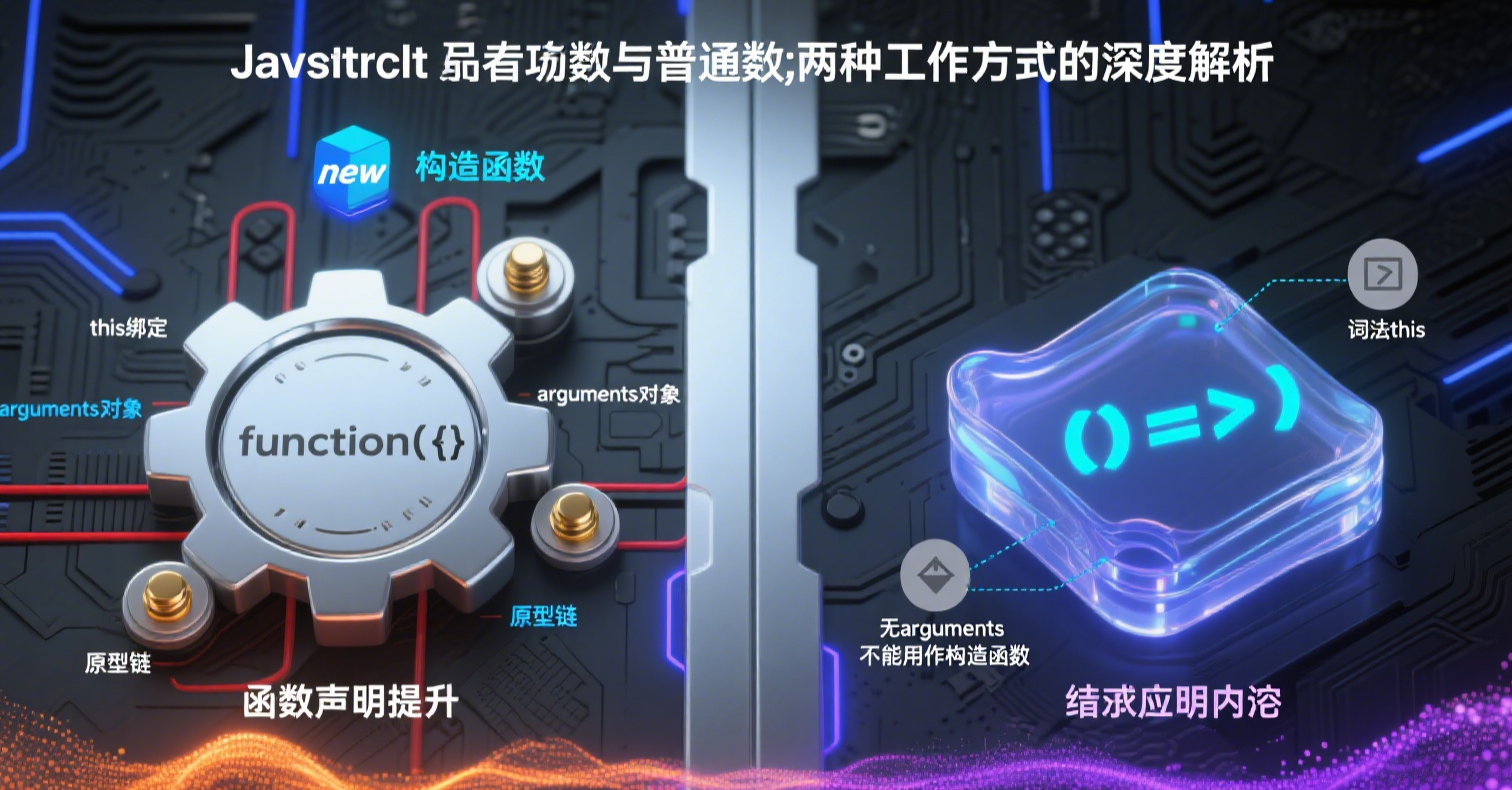文章目錄
- JavaScript箭頭函數與普通函數:兩種"工作方式"的深度解析 🏹🆚👨💼
- 引言:為什么需要箭頭函數?
- 核心區別全景圖
- 對比表格:箭頭函數 vs 普通函數
- 關系示意圖
- 一、`this`綁定的本質區別
- 1. 普通函數的`this`(誰調用就指向誰)
- 2. 箭頭函數的`this`(繼承定義時的上下文)
- 3. 實際應用場景對比
- 二、語法形式的區別
- 1. 基礎語法對比
- 2. 返回值特性
- 三、其他關鍵區別
- 1. 構造函數能力
- 2. `arguments`對象
- 3. 原型與`prototype`屬性
- 四、深度原理剖析
- 1. 箭頭函數的本質
- 2. `this`綁定原理圖
- 3. 無法改變`this`的驗證
- 五、應用場景指南
- 1. 推薦使用箭頭函數的場景
- 2. 推薦使用普通函數的場景
- 3. 混合使用示例
- 六、常見誤區與陷阱
- 1. 錯誤使用場景
- 2. 最佳實踐建議
- 3. 現代JavaScript的替代方案
- 總結:如何正確選擇?

JavaScript箭頭函數與普通函數:兩種"工作方式"的深度解析 🏹🆚👨💼
引言:為什么需要箭頭函數?
想象你在辦公室里有兩種員工:
-
普通員工(普通函數):
- 有自己獨立的辦公室(自己的
this) - 可以升任經理(可作為構造函數)
- 說話比較正式(完整語法)
- 有自己獨立的辦公室(自己的
-
靈活員工(箭頭函數):
- 共享團隊空間(繼承外層
this) - 專注具體任務(不能作為構造函數)
- 溝通簡潔高效(簡寫語法)
- 共享團隊空間(繼承外層
ES6引入箭頭函數主要是為了解決普通函數中this綁定的問題,讓代碼更簡潔,特別適合回調函數和函數式編程場景。
核心區別全景圖
對比表格:箭頭函數 vs 普通函數
| 特性 | 箭頭函數 (🏹) | 普通函數 (👨💼) |
|---|---|---|
this綁定 | 詞法作用域(定義時確定) | 動態綁定(調用時確定) |
| 構造函數 | 不能使用new | 可以使用new |
arguments | 沒有 | 有 |
| 原型屬性 | 沒有prototype | 有prototype |
| 語法 | 簡潔 | 完整 |
| 方法定義 | 不適合作為對象方法 | 適合 |
| 適用場景 | 回調、函數式編程 | 構造函數、對象方法 |
關系示意圖
普通函數
├── 有獨立的this
├── 可作為構造函數
├── 有arguments對象
└── 有prototype屬性箭頭函數
├── 繼承外層this
├── 不能作為構造函數
├── 沒有arguments
└── 更簡潔的語法
一、this綁定的本質區別
1. 普通函數的this(誰調用就指向誰)
const employee = {name: 'Alice',regularFunction: function() {console.log(this.name); // this取決于調用方式}
};employee.regularFunction(); // 'Alice' (this指向employee)const standaloneFunc = employee.regularFunction;
standaloneFunc(); // undefined (嚴格模式)或window (非嚴格模式)
2. 箭頭函數的this(繼承定義時的上下文)
const company = {name: 'TechCorp',employees: ['Alice', 'Bob'],showEmployees: function() {// 箭頭函數繼承外圍showEmployees的thisthis.employees.forEach(employee => {console.log(`${employee} works at ${this.name}`);// this正確指向company對象});// 對比普通函數this.employees.forEach(function(employee) {console.log(`${employee} works at ${this.name}`); // this指向全局或undefined});}
};company.showEmployees();
3. 實際應用場景對比
// 場景1: DOM事件處理
button.addEventListener('click', function() {console.log(this); // 指向button元素
});button.addEventListener('click', () => {console.log(this); // 指向外圍的this(通常不是我們想要的)
});// 場景2: 定時器回調
const timer = {seconds: 0,start: function() {setInterval(function() {this.seconds++; // 錯誤!this指向全局}, 1000);setInterval(() => {this.seconds++; // 正確!this指向timer對象}, 1000);}
};
二、語法形式的區別
1. 基礎語法對比
// 普通函數
const add = function(a, b) {return a + b;
};// 箭頭函數完整形式
const add = (a, b) => {return a + b;
};// 箭頭函數簡寫形式(單行返回可省略大括號和return)
const add = (a, b) => a + b;// 單個參數可省略括號
const square = x => x * x;// 無參數需要空括號
const sayHi = () => console.log('Hello');
2. 返回值特性
// 返回對象字面量需要加括號
const createUser = (name, age) => ({ name, age });// 等價于
const createUser = (name, age) => {return { name, age };
};// 多行語句需要大括號
const complexCalc = (x, y) => {const sum = x + y;const product = x * y;return sum * product;
};
三、其他關鍵區別
1. 構造函數能力
// 普通函數可作為構造函數
function Person(name) {this.name = name;
}
const alice = new Person('Alice'); // 有效// 箭頭函數不能作為構造函數
const Animal = (name) => {this.name = name; // 報錯:箭頭函數沒有this
};
const dog = new Animal('Rex'); // TypeError: Animal is not a constructor
2. arguments對象
// 普通函數有arguments對象
function sum() {let total = 0;for (let i = 0; i < arguments.length; i++) {total += arguments[i];}return total;
}
sum(1, 2, 3); // 6// 箭頭函數沒有arguments對象
const sumArrow = () => {console.log(arguments); // 報錯:arguments未定義
};// 替代方案:使用剩余參數
const sumArrow = (...args) => {return args.reduce((acc, num) => acc + num, 0);
};
sumArrow(1, 2, 3); // 6
3. 原型與prototype屬性
// 普通函數有prototype屬性
function Car() {}
console.log(Car.prototype); // 存在(用于構造函數)// 箭頭函數沒有prototype屬性
const Bike = () => {};
console.log(Bike.prototype); // undefined
四、深度原理剖析
1. 箭頭函數的本質
箭頭函數是"語法糖",但有一些根本性差異:
- 沒有自己的
this/super/arguments/new.target綁定 - 不能通過
call/apply/bind改變this - 沒有
[[Construct]]內部方法,不能作為構造函數
2. this綁定原理圖
普通函數調用時:
[函數執行] → 創建執行上下文 → 確定this值(動態)箭頭函數定義時:
[定義箭頭函數] → 捕獲外層詞法環境的this → 固定不變
3. 無法改變this的驗證
const obj1 = { name: 'Alice' };
const obj2 = { name: 'Bob' };function regularFunc() {console.log(this.name);
}const arrowFunc = () => {console.log(this.name);
};// 普通函數可以改變this
regularFunc.call(obj1); // Alice
regularFunc.call(obj2); // Bob// 箭頭函數的this始終不變(繼承定義時的this)
arrowFunc.call(obj1); // 取決于定義環境
arrowFunc.call(obj2); // 同上
五、應用場景指南
1. 推薦使用箭頭函數的場景
| 場景 | 示例 | 原因 |
|---|---|---|
| 回調函數 | array.map(x => x * 2) | 簡潔且保持this |
| 函數式編程 | const add = (a, b) => a + b | 純函數理想選擇 |
| 需要繼承this | setTimeout(() => {...}, 100) | 避免this問題 |
| 立即執行函數 | (() => { ... })() | 更簡潔的語法 |
2. 推薦使用普通函數的場景
| 場景 | 示例 | 原因 |
|---|---|---|
| 對象方法 | { method() {...} } | 需要訪問實例 |
| 構造函數 | function Person() {...} | 創建實例 |
| 需要arguments | function sum() { [...arguments] } | 箭頭函數沒有 |
| 需要動態this | button.addEventListener(...) | 需要綁定DOM元素 |
3. 混合使用示例
class Counter {constructor() {this.count = 0;// 箭頭函數作為類字段(固定this)this.increment = () => {this.count++;};}// 普通方法(原型方法)decrement() {this.count--;}// 使用箭頭函數作為回調startAutoIncrement() {setInterval(() => {this.increment();console.log(this.count);}, 1000);}
}const counter = new Counter();
counter.startAutoIncrement();
六、常見誤區與陷阱
1. 錯誤使用場景
// 陷阱1: 作為對象方法
const calculator = {value: 0,add: (x) => { this.value += x; } // 錯誤!this不會指向calculator
};// 陷阱2: 在需要動態this的場景
document.querySelector('button').addEventListener('click', () => {console.log(this); // 不是指向button元素!
});// 陷阱3: 過度簡化的箭頭函數
const complexLogic = x => x > 0 ? doSomething(x) : doSomethingElse(x); // 可讀性差
2. 最佳實踐建議
- 優先使用箭頭函數:當不需要動態
this時 - 方法使用簡寫語法:
{ method() {...} } - 避免多層嵌套:不要過度嵌套箭頭函數
- 保持可讀性:復雜邏輯還是用完整語法
- 一致性:同一項目中保持風格統一
3. 現代JavaScript的替代方案
// 類字段提案(Stage 3)
class Timer {seconds = 0; // 類字段// 使用箭頭函數作為類字段方法(自動綁定this)start = () => {setInterval(() => {this.seconds++;}, 1000);};
}// 對象方法簡寫
const obj = {// 普通方法(推薦)method1() { ... },// 箭頭函數屬性(不推薦)method2: () => { ... }
};
總結:如何正確選擇?
記住這個決策流程圖:
需要動態this嗎? → 是 → 使用普通函數↓ 否
需要作為構造函數嗎? → 是 → 使用普通函數↓ 否
需要arguments對象嗎? → 是 → 使用普通函數↓ 否
使用箭頭函數 🏹
箭頭函數和普通函數不是非此即彼的關系,而是互補的工具。理解它們的核心區別能讓你:
- 寫出更簡潔的代碼
- 避免
this相關的bug - 選擇最適合場景的函數形式
- 更好地理解現代JavaScript框架
正如JavaScript之父Brendan Eich所說:“箭頭函數是JavaScript函數式編程風格的自然補充。” 掌握它們的特性,你的代碼將會更加優雅和高效!




)





)




(54))
![[嵌入式embed][Qt]Qt5.12+Opencv4.x+Cmake4.x_用Qt編譯linux-Opencv庫 測試](http://pic.xiahunao.cn/[嵌入式embed][Qt]Qt5.12+Opencv4.x+Cmake4.x_用Qt編譯linux-Opencv庫 測試)


)